Blog - General
Dave’s June Bird Chatter 2014
Our bird feeders are certainly a source of relaxation and enjoyment as we sit on our decks and patios with thoughts of snow well behind us, for now. But Wild Bird Habitat would like to encourage everyone to take the time and look beyond the bird feeders during the summer months. There are many birds that have arrived in our area that may visit our yards or soar over our towns and neighborhoods with little concern for the feeds we provide their avian cousins.
From Chimney Swifts to Kingbirds, Flycatchers to Tree Swallows, these summer birds are well worth taking the time to observe and enjoy. Their primary prey are the insects we find so bothersome, not just to us, but to our gardens as well. These, and many other aerial birds, provide us a great service and we should do what we can to acknowledge their presence and promote their conservation.
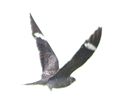
Another summer favorite is the Common Nighthawk. Not a true hawk by nature, but a voracious insect eater. They can be seen flying above the city lights on a hot summer’s night consuming mass quantities of mosquitoes, beetles, and other flying six legged creatures. Often all that is visible in the dark sky from below are the two white bars on the under wings illuminated by the street lights. But its hawk like call as it hunts the night sky can be easily be heard as it reminds us of the natural world that lies just a short distance beyond the bars and restaurants of a busy city.
So take the time this summer to explore and enjoy the other birds that share our space. They will only be here for a few short months, long enough to raise a family, and they will be gone. Winter may be the farthest thing from our mind as summer does not even officially arrive until June 21st, but for our summer birds time is of the essence. After all, by August they are already preparing for the return trip south.
The northern Goldfinches we enjoyed during the winter months have long since left, leaving us with our resident Goldfinch population. These resident finch are becoming more restless as they prepare to move into rural areas where they will begin nesting by the end of the month. A few unmated Goldfinch may continue to visit our thistle feeders in the city during the summer, and we can be assured that the House Finch will certainly continue to feed on Nyjer thistle.
Goldfinch are late nesters due to the fact they do not feed their nestlings insects, but only small thistle like seeds. This late nesting assures there will be an ample supply of seeds to feed their young. Another late nester is the Cedar Waxwing, undoubtedly because they are waiting until the first crop of berries and other fruits mature. These late nesters are also waiting for the proper nesting material to become available. Goldfinch build a tight grassy nest then line it with down from thistle plants. The nest is so tight that when it rains the adult bird must be on the nest to prevent the nest from filling with water, floating the eggs out, or drowning the nestlings.
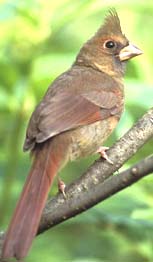
Keep vigilant for adult birds bringing their newly fledged young to the bird feeders. No doubt many have already witnessed the first crop of grackles and starlings, and their deafening squawks. But the best is yet to come. You can easily recognize Cardinal fledglings by their gray beak. That and the fact they all appear to look like the female. It will be late August before these youngster’s beaks turn the bright orange of the adult and the males gain their red plumage. Had the male fledglings carried the bright red colors of the adult, they would be chased off by the adult male as an intruder.
First year Robins are easily detected by the speckled striped breast unique to the Thrush family, which includes Bluebirds. In fact, most birds newly hatched are easily defined by their common characteristic of fluttering wings and open beak as if to say, “feed me” “feed me”.
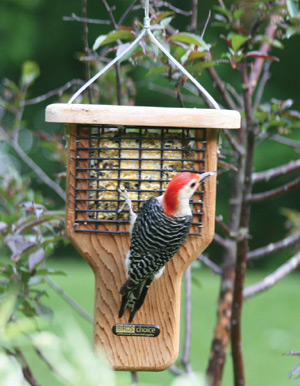
Suet during the summer months is always a treat for the woodpeckers. After all, it takes a lot of energy to defend a territory while raising and feeding a family. Woodpeckers will consume 30% more animal protein during the summer months than all winter long. And don’t be surprised to see some immature woodpeckers recently hatched brought to the suet feeders by the adult birds. It is always entertaining to watch these youngsters trying to figure out how to feed on the suet, especially if it is an up-side down suet feeder. It won’t take long for them to figure it out.
One year I had an adult male Downy Woodpecker take suet from the feeder and wipe it into a knot hole of a tree. This may have been these young birds first lesson about foraging for food around a tree trunk. Although in the past many people considered suet a winter feed product, you’ll enjoy feeding suet in the summer as well. (Ramblings cont. on back)
Feeding mealworms can add some excitement to your backyard bird feeding. Bluebirds will readily take 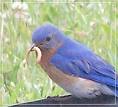 these live worms when they are placed in a dish on the ground near their nest box. They will collect them and return to the box to feed the nestlings. But what if you live in an urbanized area where bluebirds don’t nest? Well! You can still ad them to your backyard bird feeding program. Robins, Cardinals, Jays and others will enjoy them as well. You can just toss a few on the patio, or put them in a dish. Just remember, when feeding mealworms, ration them. Think of it as a daily treat for your birds.
these live worms when they are placed in a dish on the ground near their nest box. They will collect them and return to the box to feed the nestlings. But what if you live in an urbanized area where bluebirds don’t nest? Well! You can still ad them to your backyard bird feeding program. Robins, Cardinals, Jays and others will enjoy them as well. You can just toss a few on the patio, or put them in a dish. Just remember, when feeding mealworms, ration them. Think of it as a daily treat for your birds.
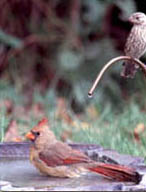 Keep bird baths cleaned and filled with fresh water. Not only is it vital that birds have clean water to drink, but to bathe in as well. It is also very amusing watching young birds attempting to figure out just how to go about taking a bath. They are just not quite sure at first. You can keep your bird bath replenished with fresh water during times of high usage, or when hot weather speeds up evaporation by adding a dripper to the bath.
Keep bird baths cleaned and filled with fresh water. Not only is it vital that birds have clean water to drink, but to bathe in as well. It is also very amusing watching young birds attempting to figure out just how to go about taking a bath. They are just not quite sure at first. You can keep your bird bath replenished with fresh water during times of high usage, or when hot weather speeds up evaporation by adding a dripper to the bath.
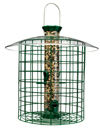
Enjoy woodpeckers and smaller birds more with one of our caged bird feeders. They keep grackles, starlings, and squirrels out while feeding woodpeckers, finch, Chickadees and others. These have come to be one of our most popular summer feeders. Ad a platform or ground bird feeder with safflower seed for the Cardinals, and you’ll have an exciting summer bird feeding program.
Now is the time to plant flowers for the return of the hummingbirds in August. Although some areas may have hummingbirds nesting and coming to the nectar feeder all summer long, most of us will see them again during migration. Tubular flowers are the ones that contain the high nectar concentrate which attracts these little jewels. Red Salvia is one of my favorites. And be ready by the first week in August with your hummingbird feeder.
